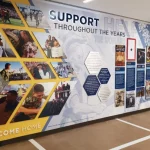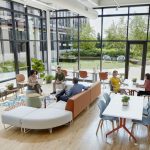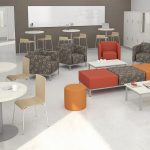Modern Classroom Design: Collaborative and Flexible Space
Modern classroom design is being driven by rapidly advancing technology, education models have moved towards classrooms where students can easily make connections. The needs of 21st century learners and teachers have changed, leading to a transformation in modern classroom design. The new classroom is one that has a variety of flexible seating options, moveable table arrangements, and accessible technology throughout.
Research shows that learning styles have changed. According to the Center on Teaching and Learning at the University of Oregon, the new generation of learners prefer to multitask, are highly networked and interactive in their learning, learn actively rather than passively, and rely heavily on communications technology to access information. In order for the 21st Century learner to be active and engaged, collaborative modern classroom design is necessary.
What Does Modern Classroom Design Look Like?
Flexible seating options: Classrooms should have different seating choices. Options include: chairs on wheels providing ease in mobility for group work and collaborative learning; chairs that rock, stools of differing heights, or even some bean bag chairs offering students the flexibility that they desire.
Teacher stations: Teachers used to have a designated corner of the room that took up 25 percent of the classroom, experts recommend using smaller, moveable teacher stations to allow for more student space, providing teachers the flexibility and mobility they need to interact with their students effortlessly.
Moveable tables/adjustable student work stations: Instead of traditional desks, tables on wheels make it easy for teachers to reconfigure the classroom according to the activity. Furniture should be lightweight and moveable to accommodate workgroups of different sizes. Table size and shape can vary to offer flexibility for the space.
Technology Integration: Classrooms have mobile carts which double as a powering stations for laptops and tablets, data plugs and outlets should be easily accessible for students, and classrooms should be equipped with wireless capabilities for students to connect.
With these simple design changes, students stand to benefit in many ways. Research states that educational experiences that are active, social, and engaging lead to deeper learning. Case studies have also found that collaborative classrooms lead to improved grades, happier learners, and more real world connections to learning; collaborative and flexible spaces are the new standard for 21st century classroom design.
Sources:
1. UNC Charlotte, The Center for Teaching and Learning website. “Collaborative Learning Spaces.”
2. “Flexible Classrooms: Providing the Learning Environment That Kids Need.” Edutopia.
3. “Collaborative Learning;Group Work.” Cornell University Center For Teaching Excellence.
4.”Designing Learning Spaces for 21st Century Learners.” University of Oregon Center on Teaching and Learning.










